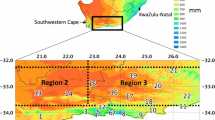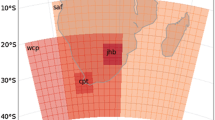Abstract
Synoptic circulation patterns, defined as anomalies in sea level pressure (SLP), 500 hPa geopotential height (Z500), and 250 hPa wind speed (V250) and referred to as large-scale meteorological patterns (LSMPs), are characterized using the self-organizing maps approach over southern South America. Results show a wide range of possible LSMP types over a 37-year period of study. LSMP type variability can be summarized as a spectrum from patterns dominated by positive SLP and Z500 anomalies with a poleward displacement of the strongest 250 hPa winds, to patterns dominated by similar structures but with anomalies of opposite sign. The LSMPs found are connected with lower tropospheric temperature and wind, precipitation, and the frequency of atmospheric rivers (ARs). This highlights LSMPs more closely associated with anomalous and potentially impactful surface meteorology. Results show ARs as primary drivers of heavy precipitation over some of the region and connect their occurrence to driving synoptic dynamics. Two important low frequency modes of climate variability, the Southern Annular Mode (SAM) and the El Nino Southern Oscillation (ENSO), show some influence on the frequency of LSMP type, with the SAM more directly related to LSMP type modulation than ENSO. This comprehensive climatology of synoptic variability across southern South America has potential to aid in a mechanistic approach to studying climate change projections of temperature, precipitation, and AR frequency in climate models.












Similar content being viewed by others
References
Andreoli RV, Kayano MT (2005) ENSO-related rainfall anomalies in South American and associate circulation features during warm and cold Pacific Decadal Oscillation regimes. Int J Climatol 25:2017–2030
Cassano EN, Glisan JM, Cassano JJ, Gutowski J, Seefeldt MW (2015) Self-organizing maps analysis of widespread temperature extremes in Alaska and Canada. Clim Res 62:199–218
Cassano JJ, Cassano EN, Seefeldt MW, Gutowski WJ, Glisan JM (2016) Synoptic conditions during wintertime temperature extremes in Alaska. J Geophys Res Atmos 121:3241–3262
Chen R, Lu R (2016) Role of large-scale circulation and terrain in causing extreme heat in western China. J. Clim 29:2511–2527
Chen HW, Alley RB, Zhang F (2016) Interannual Arctic sea ice variability and associated winter weather patterns: a regional perspective for 1979–2014. J Geophys Res Atmos 121:14433–14455. https://doi.org/10.1002/2016jd024769
Dacre HF, Clark PA, Martinez-Alvarado O, Stringer MA, Lavers DA (2015) How do atmospheric rivers form? Bull Am Meteorol Soc 96:1243–1255
DeAngeles AM, Broccoli AJ, Decker SG (2013) A comparison of CMIP3 simulations of precipitation over North America with observations: daily statistics and circulation features accompanying extreme events. J Clim 26:3209–3230
Fogt RL, Bromwich DH (2006) Decadal variability of the ENSO teleconnection to the high-latitude South Pacific governed by coupling with the southern annular mode. J Clim 19:979–997
Ford TW, Schoof JT (2016) Characterizing extreme and oppressive heat waves in Illinois. J Geophys Res Atmos 121:3326–3338. https://doi.org/10.1002/2016jd025721
Garreaud RD, Vuille M, Compagnucci R, Marengo J (2009) Present-day South American climate. Palaeogeogr Palaeoclimatol Palaeoecol 281:180–195
Geirinhas JL, Trigo RM, Libonati R, Coelho CAS, Palmeira AC (2018) Climatic and synoptic characterization of heat waves in Brazil. Int J Climatol 38:1760–1776
Gelaro R et al (2017) The modern-era retrospective analysis for research and applications, version 2 (MERRA-2). J Clim 30:5419–5454
Gervais M, Atallah E, Gyakum JR, Tremblay LB (2016) Arctic air masses in a warming world. J Clim 29:2359–2373
Gibson PB, Perkins-Kirkpatrick SE, Uotila P, Pepler AS, Alexander LV (2017) On the use of self-organizing maps for studying climate extremes. J Geophys Res Atmos 122:3891–3903
Gillett NP, Kell TD, Jones PD (2006) Regional climate impacts of the Southern Annular Mode. Geophys Res Lett 33:L23704
Gimeno L, Nieto R, Vázquez M, Lavers DA (2014) Atmospheric rivers: a mini-review. Front Earth Sci 2:2.1–2.6
Gimeno L, Dominguez F, Nieto R, Trigo R, Drumond A, Reason CJC, Taschetto AS, Ramos AM, Kumar R, Marengo J (2016) Major mechanisms of atmospheric moisture transport and their role in extreme precipitation. Annu Rev Environ Resour 41:117–141
Glisan JM, Gutowski WJ, Cassano JJ, Cassano EN, Seefeldt MW (2016) Analysis of WRF extreme daily precipitation over Alaska using self-organizing maps. J Geophys Res Atmos 121:7746–7761
Grimm AM, Tedeschi RG (2009) ENSO and extreme rainfall events in South America. J Clim 22:1589–1609
Grimm AM, Barros VR, Doyle ME (2000) Climate variability in southern South America associated with El Nino and La Nina events. J Clim 13:35–58
Grotjahn R, Lee Y-Y (2016) On climate model simulations of the large-scale meteorology associated with California heat waves. J Geophys Res Atmos 121:18–32
Grotjahn R et al (2016) North American extreme temperature events and related large scale meteorological patterns: a review of statistical methods, dynamics, modeling, and trends. Clim Dyn 46:1151–1184
Guan B, Waliser DE (2015) Detection of atmospheric rivers: Evaluation and application of an algorithm for global studies. J Geophys Res Atmos 120:12514–12535. https://doi.org/10.1002/2015JD024257
Guan B, Waliser DE, Ralph FM (2018) An intercomparison between reanalysis and dropsonde observations of the total water vapor transport in individual atmospheric rivers. J Hydrometeorol 19:321–337. https://doi.org/10.1175/JHM-D-17-0114.1
Hewitson BC, Crane RG (2002) Self-organizing maps: applications to synoptic climatology. Clim Res 22:13–26
Johnson NC, Feldstein SB (2010) The continuum of North Pacific sea level pressure patterns: intraseasonal, interannual, and interdecadal variability. J Clim 23:851–867
Johnson NC, Feldstein SB, Tremblay B (2008) The continuum of Northern Hemisphere teleconnection patterns and a description of the NAO shift with the use of self-organizing maps. J Clim 21:6354–6371
Kawazoe S, Gutowski WJ (2013) Regional very heavy daily precipitation in NARCCAP simulations. J Hydrometeorol 14:1212–1227
Kayano MT, Andreoli RV, De Souza RAF (2011) Evolving anomalous SST patterns leading to ENSO extremes. Relations between the tropical Pacific and Atlantic Oceans and the influence on the South American rainfall. Int J Climatol 31:1119–1134
Kayano MT, Andreoli RV, de Souza RAF, Garcia SR (2017) Spatiotemporal variability modes of surface air temperature in South America during the 1951–2010 period: ENSO and non-ENSO components. Int J Climatol 37:1–13
Knight JR, Allen RJ, Folland CK, Vellinga M, Mann ME (2005) A signature of persistent natural thermohaline circulation cycles in observed climate. Geophys Res Lett 32:L20708
Knight JR, Folland CK, Scaife AA (2006) Climate impacts of the Atlantic Multidecadal Oscillation. Geophys Res Lett 33:L17706
Krueger O, Hegerl GC, Tett SFB (2015) Evaluation of mechanisms of hot and cold days in climate models over Central Europe. Environ Res Lett 10:014002
Lau N-C, Nath MJ (2012) A model study of heat waves over North America: meteorological aspects and projections for the twenty-first century. J Clim 25:4761–4784
Lavers DA, Villarini G, Allan RP, Wood EF, Wade AJ (2012) The detection of atmospheric rivers in atmospheric reanalyses and their links to British winter floods and the large-scale climatic circulation. J Geophys Res 117:D20106. https://doi.org/10.1029/2012JD018027
Lee Y-Y, Gotjahn R (2016) California Central Valley summer heat waves from two ways. J Clim 29:1201–1217
Lennard C, Hegerl G (2015) Relating changes in synoptic circulation to the surface rainfall response using self-organising maps. Clim Dyn 44:861–879
Loikith PC, Broccoli AJ (2012) Characteristics of observed atmospheric circulation patterns associated with temperature extremes over North America. J Clim 25:7266–7281
Loikith PC, Broccoli AJ (2015) Comparison between observed and model-simulated atmospheric circulation patterns associated with extreme temperature days over North America using CMIP5 historical simulations. J Clim 28:2063–2079
Loikith PC, Waliser DE, Lee H, Neelin JD, Lintner B, McGinnis S, Mearns L, Kim J (2015) Evaluation of large-scale meteorological patterns associated with temperature extremes in the NARCCAP regional climate model simulations. Clim Dyn 45:3257–3274
Loikith PC, Lintner B, Sweeney A (2017a) Characterizing large-scale meteorological patterns and associated temperature and precipitation extremes over the northwestern United States using self-organizing maps. J Clim 30:2829–2847
Loikith PC, Detzer J, Mechoso CR, Lee H, Barkhordarian A (2017b) The influence of recurrent modes of climate variability on the occurrence of monthly temperature extremes over South America. J Geophys Res Atmos. https://doi.org/10.1002/2017JD027561
Muñoz ÁG, Goddard L, Robertson AW, Kushnir Y, Baethgen W (2015) Cross-time scale interactions and rainfall extreme events in southeastern South America for the austral summer. Part I: potential predictors. J Clim 28:7894–7913
Neiman PJ, Ralph FM, Wick GA, Lundquist JD, Dettinger MD (2008) Meteorological characteristics and overland precipitation impacts of atmospheric rivers affecting the West Coast of North America based on eight years of SSM/I satellite observations. J Hydrometeorol 9:22–47. https://doi.org/10.1175/2007JHM855.1
Pezza AB, van Rensch P, Cai W (2012) Severe heat waves in Southern Australia: synoptic climatology and large scale connections. Clim Dyn 38:209–224
Radic V, Cannon AJ, Menounos B, Nayeob G (2015) Future changes in autumn atmospheric river events in British Columbia, Canada, as projected CMIP global climate models. J Geophys Res Atmos 120:9279–9302
Ralph FM, Neiman PJ, Wick GA (2004) Satellite and CALJET aircraft observations of atmospheric rivers over the eastern North Pacific Ocean during the winter of 1997/98. Mon Weather Rev 132:1721–1745
Reboita MS, Ambrizzi T, Porfírio da Rocha R (2009) Relationship between the southern annular mode and southern hemisphere atmospheric systems. Rev Bras Meteorol 24:48–55
Reichle RH et al (2018) Land surface precipitation in MERRA-2. J Clim 30:1643–1664
Renom M, Rusticucci M, Barreiro M (2011) Multidecadal changes in the relationship between extreme temperature events in Uruguay and the general atmospheric circulation. Clim Dyn 37:2471–2480
Ryoo J-M, Waliser DE, Waugh DW, Wong S, Fetzer EJ, Fung I (2015) Classification of atmospheric river events on the U.S. West Coast using a trajectory model. J Geophys Res Atmos 120:3007–3028
Sheridan SC, Lee CC (2011) The self-organizing map in synoptic climatological research. Prog Phys Geogr 35:109–119
Silvestri G, Vera C (2009) Nonstationary impacts of the southern annular mode on southern hemisphere climate. J Clim 22:6142–6148
Solman SA, Menendez CG (2003) Weather regimes in the South American sector and neighbouring oceans during winter. Clim Dyn 21:91–104
Thompson DWJ, Wallace JM (2000) Annular modes in the extratropical circulation. Part I: month-to-month variability. J Clim 13:1000–1016
Viale M, Valenzuela R, Garreaud RD, Ralph MF (2018) Impacts of atmospheric rivers on precipitation in southern South America. J Hydrometeorol 19:1671–1687
Waliser D, Guan B (2017) Extreme winds and precipitation during landfall of atmospheric rivers. Nat Geosci 10:179–183
Warner MD, Mass CF (2017) Changes in climatology, structure, and seasonality of northeast Pacific atmospheric rivers in CMIP5 climate simulations. J Hydrometeorol 18:2131–2141
Wolter K, Timlin MS (1998) Measuring the strength of ENSO events: how does 1997/1998 rank? Weather 53:315–324
Xie Z, Black RX, Deng Y (2017) The structure and large-scale organization of extreme cold waves over the conterminous United States. Clim Dyn 49:4075–4088
Zhu Y, Newell RE (1998) A proposed algorithm for moisture fluxes from atmospheric rivers. Mon Weather Rev 126:725–735
Acknowledgements
P. L., J. D., C. R. M., and A. B. acknowledge support from the U.S. National Science Foundation AGS-1547899. E. S. acknowledges support from the NASA Indicators for the National Climate Assessment (NCA) Program. Climate indices are obtained from the U.S. National Oceanic and Atmospheric Administration via the Web at https://www.esrl.noaa.gov/psd/data/climateindices/list/. MERRA2 reanalysis is available from the U.S. National Aeronautics and Space Administration via the Web at https://gmao.gsfc.nasa.gov/reanalysis/MERRA/. ERA-Interim data are available via the Web at https://www.ecmwf.int/en/research/climate-reanalysis/era-interim. University of Delaware data are available at https://www.esrl.noaa.gov/psd/data/gridded/data.UDel_AirT_Precip.html. We thank Hans Von Storch and Silvina Solman for their helpful contribution and guidance on this work. We thank Nathaniel Johnson for providing the SOMs Matlab code.
Author information
Authors and Affiliations
Corresponding author
Additional information
Publisher's Note
Springer Nature remains neutral with regard to jurisdictional claims in published maps and institutional affiliations.
Rights and permissions
About this article
Cite this article
Loikith, P.C., Pampuch, L.A., Slinskey, E. et al. A climatology of daily synoptic circulation patterns and associated surface meteorology over southern South America. Clim Dyn 53, 4019–4035 (2019). https://doi.org/10.1007/s00382-019-04768-3
Received:
Accepted:
Published:
Issue Date:
DOI: https://doi.org/10.1007/s00382-019-04768-3




